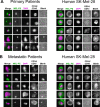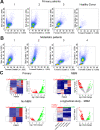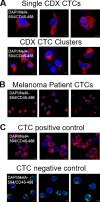The RPL/RPS gene signature of melanoma CTCs associates with brain metastasis
- PMID: 36407834
- PMCID: PMC9668078
- DOI: 10.1158/2767-9764.crc-22-0337
The RPL/RPS gene signature of melanoma CTCs associates with brain metastasis
Abstract
Melanoma brain metastasis (MBM) is linked to poor prognosis and low overall survival. We hypothesized that melanoma circulating tumor cells (CTCs) possess a gene signature significantly expressed and associated with MBM. Employing a multi-pronged approach, we provide first-time evidence identifying a common CTC gene signature for ribosomal protein large/small subunits (RPL/RPS) which associate with MBM onset and progression. Experimental strategies involved capturing, transcriptional profiling and interrogating CTCs, either directly isolated from blood of melanoma patients at distinct stages of MBM progression or from CTC-driven MBM in experimental animals. Second, we developed the first Magnetic Resonance Imaging (MRI) CTC-derived MBM xenograft model (MRI-MBM CDX) to discriminate MBM spatial and temporal growth, recreating MBM clinical presentation and progression. Third, we performed the comprehensive transcriptional profiling of MRI-MBM CDXs, along with longitudinal monitoring of CTCs from CDXs possessing/not possessing MBM. Our findings suggest that enhanced ribosomal protein content/ribogenesis may contribute to MBM onset. Since ribosome modifications drive tumor progression and metastatic development by remodeling CTC translational events, overexpression of the CTC RPL/RPS gene signature could be implicated in MBM development. Collectively, this study provides important insights for relevance of the CTC RPL/RPS gene signature in MBM, and identify potential targets for therapeutic intervention to improve patient care for melanoma patients diagnosed with or at high-risk of developing MBM.
Keywords: CTC transcriptional profiling; CTC-derived xenografts (CDXs); Circulating Tumor Cells (CTCs); Magnetic Resonance Imaging (MRI); Melanoma Brain Metastasis (MBM); Ribosomal proteins of large/small subunits (RPL/RPS) gene signature.
Conflict of interest statement
Conflicts of Interest: Authors declare no conflict of interest.
Figures








Similar articles
-
A Melanoma Brain Metastasis CTC Signature and CTC:B-cell Clusters Associate with Secondary Liver Metastasis: A Melanoma Brain-Liver Metastasis Axis.Cancer Res Commun. 2025 Feb 1;5(2):295-308. doi: 10.1158/2767-9764.CRC-24-0498. Cancer Res Commun. 2025. PMID: 39831781 Free PMC article.
-
Targeting Translation and the Cell Cycle Inversely Affects CTC Metabolism but Not Metastasis.Cancers (Basel). 2023 Nov 2;15(21):5263. doi: 10.3390/cancers15215263. Cancers (Basel). 2023. PMID: 37958436 Free PMC article.
-
Application of CTC discoveries for liquid biopsy: the RPL/RPS gene signature of melanoma CTCs is linked to brain metastasis onset.Clin Exp Metastasis. 2024 Aug;41(4):413-415. doi: 10.1007/s10585-023-10255-1. Epub 2024 Jan 12. Clin Exp Metastasis. 2024. PMID: 38212568 No abstract available.
-
CTC-Derived Models: A Window into the Seeding Capacity of Circulating Tumor Cells (CTCs).Cells. 2019 Sep 25;8(10):1145. doi: 10.3390/cells8101145. Cells. 2019. PMID: 31557946 Free PMC article. Review.
-
Circulating tumor cells as Trojan Horse for understanding, preventing, and treating cancer: a critical appraisal.Cell Mol Life Sci. 2020 Sep;77(18):3671-3690. doi: 10.1007/s00018-020-03529-4. Epub 2020 Apr 24. Cell Mol Life Sci. 2020. PMID: 32333084 Free PMC article. Review.
Cited by
-
Genomic and Transcriptional Profiling of Chinese Melanoma Patients Enhanced Potentially Druggable Targets: A Multicenter Study.Cancers (Basel). 2022 Dec 31;15(1):283. doi: 10.3390/cancers15010283. Cancers (Basel). 2022. PMID: 36612279 Free PMC article.
-
A Melanoma Brain Metastasis CTC Signature and CTC:B-cell Clusters Associate with Secondary Liver Metastasis: A Melanoma Brain-Liver Metastasis Axis.Cancer Res Commun. 2025 Feb 1;5(2):295-308. doi: 10.1158/2767-9764.CRC-24-0498. Cancer Res Commun. 2025. PMID: 39831781 Free PMC article.
-
New insights into the correlations between circulating tumor cells and target organ metastasis.Signal Transduct Target Ther. 2023 Dec 21;8(1):465. doi: 10.1038/s41392-023-01725-9. Signal Transduct Target Ther. 2023. PMID: 38129401 Free PMC article. Review.
-
Deep neural network based tissue deconvolution of circulating tumor cell RNA.J Transl Med. 2023 Nov 4;21(1):783. doi: 10.1186/s12967-023-04663-w. J Transl Med. 2023. PMID: 37925448 Free PMC article.
-
Alternative Wnt-signaling axis leads to a break of oncogene-induced senescence.Cell Death Dis. 2024 Feb 22;15(2):166. doi: 10.1038/s41419-024-06550-8. Cell Death Dis. 2024. PMID: 38388496 Free PMC article.
References
-
- Johnson JD, Young B. Demographics of brain metastasis. Neurosurg Clin N Am 1996;7:337–44. - PubMed
Publication types
MeSH terms
Substances
Grants and funding
LinkOut - more resources
Full Text Sources
Medical

